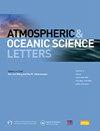数值模式和数据驱动网络的侧向边界条件对对流尺度集合预报的影响
IF 3.2
4区 地球科学
Q3 METEOROLOGY & ATMOSPHERIC SCIENCES
引用次数: 0
摘要
本文研究了数值模式和数据驱动网络提供的侧向边界条件对对流尺度集合预报的影响。在杭州RDP(第19届杭州亚运会对流尺度集合预报与应用研究发展项目)试验台上进行了4项试验,LBCs分别来自国家环境预报中心(NCEP)全球预报系统(GFS) 33垂直层预报(Exp_GFS)、盘古13垂直层预报(Exp_Pangu)、阜西13垂直层预报(Exp_Fuxi)、NCEP GFS预报垂直高度降至13(与exp_盘古和exp_伏西预报相同)(Exp_GFSRDV)。一般来说,Exp_Pangu的性能与Exp_GFS相当,而Exp_Fuxi的性能略低于Exp_Pangu,这可能是由于其大规模预测的准确性较低。因此,利用数据驱动网络有效地为对流尺度集合预报提供lbc的能力已得到证明。此外,Exp_GFSRDV在四个实验中对流尺度预测最差,这表明通过增加网络的垂直水平,数据驱动网络对lbc有潜在的改善作用。然而,四个实验的集合分布几乎不随提前时间的增加而增加。因此,每个实验都没有足够的集合扩展来呈现现实的预测不确定性,这将在未来的研究中进行研究。四组实验的边界条件分别来自美国国家环境预报中心(NCEP)全球预报系统(GFS)的33层预报(Exp_GFS), 13层预报(Exp_GFSRDV),盘古(盘古)的预报(Exp_Pangu)和伏羲(伏羲)的预报(Exp_Fuxi)。结果表明,Exp_Pangu的预报表现与Exp_GFS相当,而Exp_Fuxi的预报表现略逊于Exp_Pangu,这可能是因为盘古的预报在大尺度上比伏羲更准确,因此人工智能大模型能有效地为对流尺度集合预报提供边界条件。此外,在四组实验中,Exp_GFSRDV的预报结果最差,这表明通过增加神经网络的垂直层数,有潜力进一步改进使用人工智能大模型提供边界条件的预报结果。然而, 四组实验的集合离散度几乎不会随着预报时长的增加而变大, 因此其集合离散度不足以表征预报的不确定性, 这点将在后续进一步研究.本文章由计算机程序翻译,如有差异,请以英文原文为准。

Impacts of lateral boundary conditions from numerical models and data-driven networks on convective-scale ensemble forecasts
The impacts of lateral boundary conditions (LBCs) provided by numerical models and data-driven networks on convective-scale ensemble forecasts are investigated in this study. Four experiments are conducted on the Hangzhou RDP (19th Hangzhou Asian Games Research Development Project on Convective-scale Ensemble Prediction and Application) testbed, with the LBCs respectively sourced from National Centers for Environmental Prediction (NCEP) Global Forecast System (GFS) forecasts with 33 vertical levels (Exp_GFS), Pangu forecasts with 13 vertical levels (Exp_Pangu), Fuxi forecasts with 13 vertical levels (Exp_Fuxi), and NCEP GFS forecasts with the vertical levels reduced to 13 (the same as those of Exp_Pangu and Exp_Fuxi) (Exp_GFSRDV). In general, Exp_Pangu performs comparably to Exp_GFS, while Exp_Fuxi shows slightly inferior performance compared to Exp_Pangu, possibly due to its less accurate large-scale predictions. Therefore, the ability of using data-driven networks to efficiently provide LBCs for convective-scale ensemble forecasts has been demonstrated. Moreover, Exp_GFSRDV has the worst convective-scale forecasts among the four experiments, which indicates the potential improvement of using data-driven networks for LBCs by increasing the vertical levels of the networks. However, the ensemble spread of the four experiments barely increases with lead time. Thus, each experiment has insufficient ensemble spread to present realistic forecast uncertainties, which will be investigated in a future study.
摘要
本文探讨了基于人工智能大模型的边界条件对对流尺度集合预报的影响. 四组实验的边界条件分别来自美国国家环境预报中心 (NCEP) 全球预报系统 (GFS) 的33层预报 (Exp_GFS) , 13层预报 (Exp_GFSRDV) , 盘古 (Pangu) 的预报 (Exp_Pangu) 和伏羲 (Fuxi) 的预报 (Exp_Fuxi) . 结果表明, Exp_Pangu的预报表现与Exp_GFS相当, 而Exp_Fuxi的预报表现略逊于Exp_Pangu, 这可能是因为盘古的预报在大尺度上比伏羲更准确, 因此人工智能大模型能有效地为对流尺度集合预报提供边界条件. 此外, 在四组实验中, Exp_GFSRDV的预报结果最差, 这表明通过增加神经网络的垂直层数, 有潜力进一步改进使用人工智能大模型提供边界条件的预报结果. 然而, 四组实验的集合离散度几乎不会随着预报时长的增加而变大, 因此其集合离散度不足以表征预报的不确定性, 这点将在后续进一步研究.
求助全文
通过发布文献求助,成功后即可免费获取论文全文。
去求助
来源期刊

Atmospheric and Oceanic Science Letters
METEOROLOGY & ATMOSPHERIC SCIENCES-
CiteScore
4.20
自引率
8.70%
发文量
925
审稿时长
12 weeks
 求助内容:
求助内容: 应助结果提醒方式:
应助结果提醒方式:


